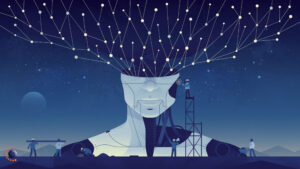
Few biometric technologies have received as many reactions – positive or negative – as facial recognition. When combined with artificial intelligence, face recognition is highly accurate but can be considered invasive. Today, we’ll take a look at how AI is incorporated in facial recognition technology and what its implications are.
WHAT IS AI FACE RECOGNITION?
Facial recognition technology is a set of algorithms that work together to identify people in a video or a static image. This technology has existed for decades, but it has become much more prevalent and innovative in recent years.
One such innovation is the integration of artificial intelligence (AI) within facial recognition systems. Intelligent, AI-based software can instantaneously search databases of faces and compare them to one or multiple faces that are detected in a scene. In an instant, you can get highly accurate results – typically, systems deliver 99.5% accuracy rates on public standard data sets.
AI face recognition software has the following advantages:
- Real-time identification;
- Anti-spoofing measures;
- Lessened racial or gender bias due to model training across millions of faces;
- Can be used across multiple cameras.
WHAT IS AI? PUBLIC STANDARD DATA SETS
Artificial Intelligence (AI) is a vast subset of computer science revolving around the development of smart machines that can perform tasks that typically need some semblance of human intelligence. It is a multi-faceted, interdisciplinary science, but modern advancements in deep learning and machine learning are bringing it into nearly every area of the tech industry.
WHAT IS DEEP LEARNING?

Deep learning is a function of AI; it imitates the processing power and pattern-creation capabilities of the human brain and uses those abilities to make decisions. Deep learning is a subset of AI’s machine learning, and it has networks that can learn from unstructured or unlabeled data – and it can do so without supervision. Deep learning is also referred to as a “deep neural network” or “deep neural learning.”
HOW AI FACIAL RECOGNITION WORKS
The basic way that AI in facial recognition works is that you begin with a tagged feature set. Essentially, you are starting with photos that have existing, hand-matched correlations to the people involved. There needs to be an initial, manual correlation between a person’s face and the rest of their identity. And once that gets started, it becomes steadily easier to identify faces in pictures of people “in the wild” – so to speak, in which pictures that aren’t as clear are matched to that data set.
And how, exactly, is AI able to recognize faces? Well, each person’s face is broken up into numerous data points; these can be the distance between the eyes, the height of the cheekbones, the distance between the eyes and the mouth, and so on. AI facial recognition searches on those data points and tries to account for variations (for instance, distance from the camera and slight variations in the angle of the face).
WHERE IS FACE RECOGNITION AI USED TODAY?

Face recognition AI is applied to many industries nowadays. For instance:
- Health care. Computer vision is combined with AI to support pain management procedures and track patient medication consumption.
- Security. Deep learning algorithms are helping to reduce the need for regular passwords on mobile devices, recognize fraud detection, and improve anti-spoofing capabilities.
- Airport boarding: Each year, over 100,000,000 people pass through Paris’ Orly and Charles de Gaulle airports. To speed things up, the airports have begun using “smart gates,” which use a combination of facial identification and liveliness checks.
- Proctoring: Some proctor services use AI solutions to detect and document suspicious behavior via webcam monitoring. Live proctors can then analyze and contextualize those events.
Source: RECFACES



































































